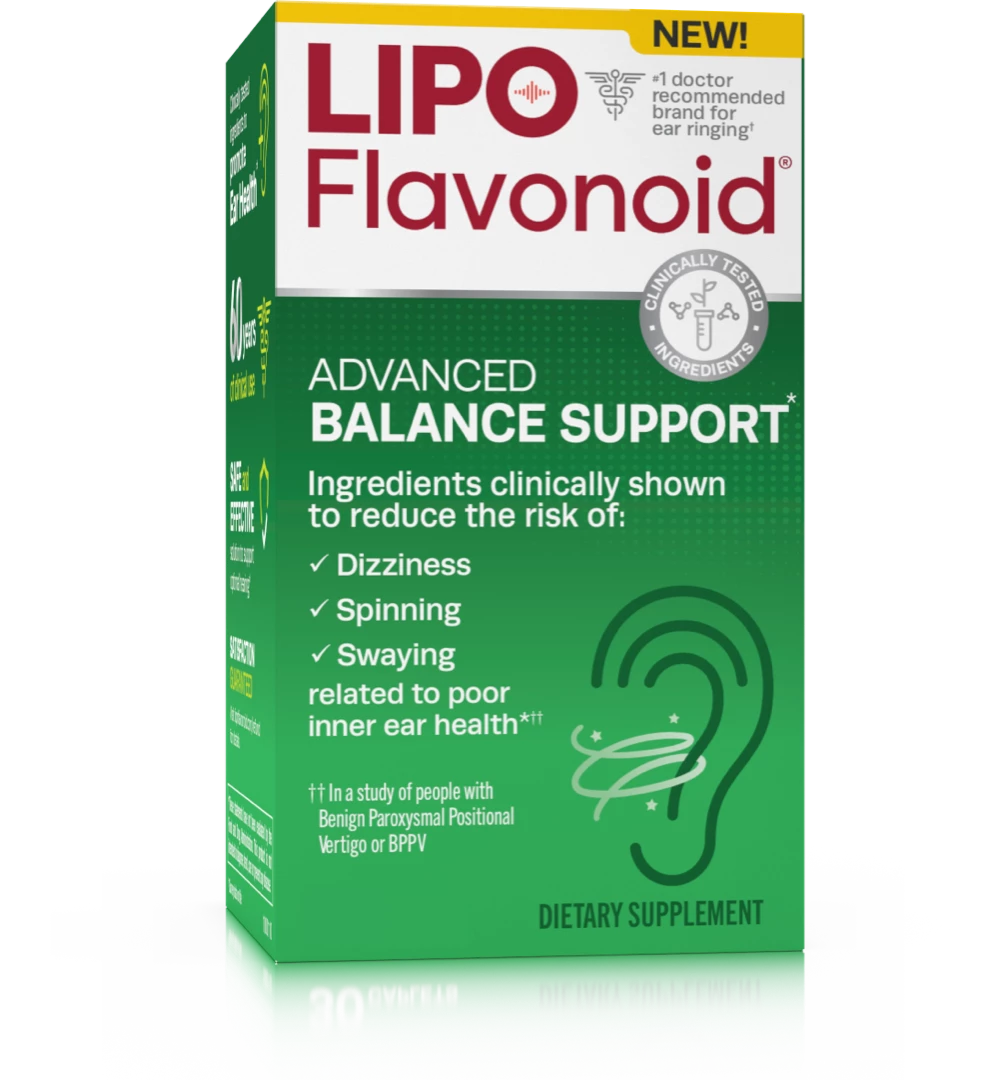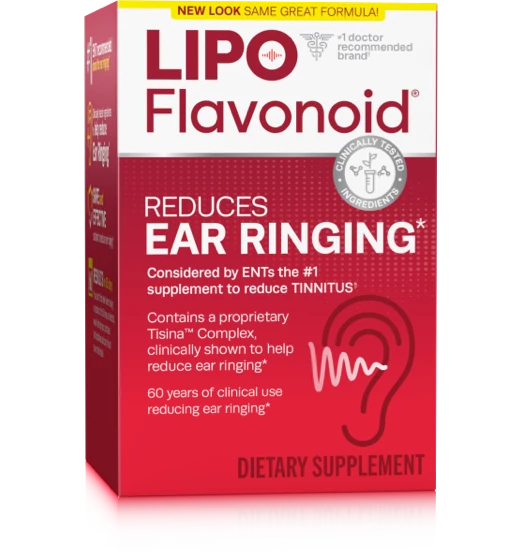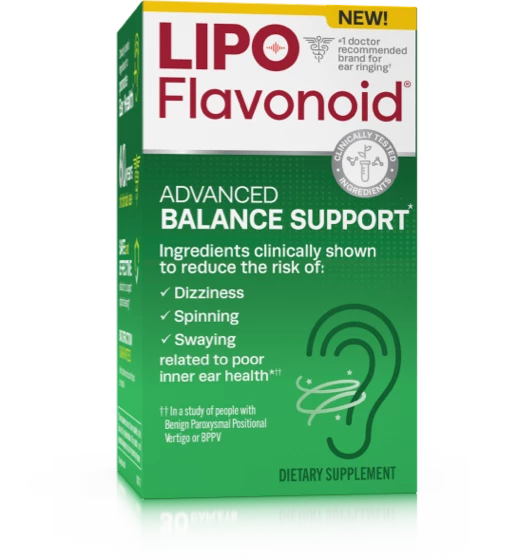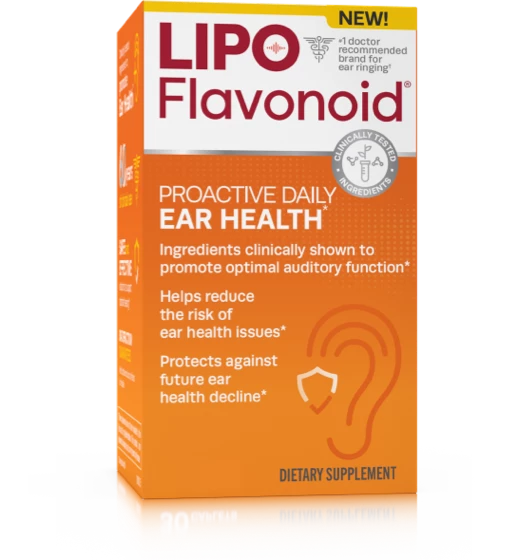- Products
- Science
-
Resources
- Tinnitus Resources
- What is tinnitus?
- Causes of tinnitus
- Tips for managing tinnitus
- Prepare for your doctor's visit
- PTSD and tinnitus
- Tinnitus FAQs
- Hearing Loss Resources
- What is hearing loss?
- Degrees of hearing Impairment
- Types of hearing loss
- Causes of hearing loss
- Treatment options for hearing loss
- Buy Now
- Coupons
- Test Your Hearing
- Test Your Hearing
- Healthcare Professionals
Vertigo and BalanceResources
What is Vertigo?
More than 36 million people (65%) of people in the U.S. aged 60 and older experience dizziness or loss of balance, often daily.
Spells of dizziness, spinning or swaying can be defined as Vertiginous conditions, often referred to as Vertigo. Vertigo is often triggered by the change in the position of your head and can last for minutes or hours. Unfortunately, these conditions are common, especially in older patients, and can increase falls, depression, social isolation, fear, and overall dysfunction - all contributing to poor health and outcomes. Dizziness is a major predictor of falls in the elderly, the leading cause of accidental death after the age of 65.9
There are a number of things that can cause these symptoms, especially as you age. Beyond inner ear issues, some common causes the general decline in vision and sensory systems, poor circulation, medications, and various diseases affecting the nervous system. Because there can be so many different causes of vertigo, it is important to consult with your doctor so you know what treatment might be right for you. 29% of older adults in the U.S. have fallen at least once in the last year, resulting in an estimated 29.0 million falls.
Symptoms of Vertigo
- Spinning
- Tilting
- Swaying
- Unbalance
- Pulled in one direction
Types of Vertigo and their Causes
Benign paroxysmal positional vertigo (BPPV)
is the most commonly diagnosed vertiginous condition in the United States. Affecting at least 9% of adults aged 18 to 35 and seven times more older adults, BPPV symptoms tend to recur and worsen with age due to the decline of inner ear structures. Tiny calcium particles (canaliths) are dislodged from their normal location and collect in the inner ear and the signals it sends to the brain become confused relative to gravity.
Meniere's disease
is a disorder of the inner ear, which is believed to result from the accumulation of fluid and pressure changes in the ear. This condition can lead to episodes of vertigo, accompanied by tinnitus and hearing loss.
Vestibular neuritis or labyrinthitis
is an inner ear condition typically linked to infection, frequently viral in nature. The infection triggers inflammation in the inner ear, specifically around nerves that are critical for sending signals to the brain that help you balance.
Vertigo may also occasionally be associated with other conditions, such as head or neck injury, brain problems like stroke or tumor, certain medications that damage the ear, and migraine headaches.
Treatment Options
Several treatment options are available for Vertigo conditions, but the type best for you depends on the cause and severity of your condition so please see your doctor for an official diagnosis to find the right treatment for you. (UCSFHealth.org)
Dietary Supplements
Nutrition plays a key role in getting a healthy supply of certain nutrients to the inner ear and vestibular system to protect inner ear cells and maintain circulation. It is difficult to get all of the essential vitamins and nutrients through your diet, so an easy solution is to buy a daily over-the-counter supplement. A multivitamin likely does not contain the essential ingredients so look for a specialized supplement with proven ingredients like, Ginkgo Biloba, B Complex, and Bioflavonoids. This treatment is exciting because it is relatively new and is much less expensive and low risk than going to the doctor to have them perform head movements or prescribe medications.
To learn more about the ingredients and science behind our Advanced Balance Support supplement go to our Science page.
Repositioning Maneuvers
There are several types of repositioning movements to treat vertigo symptoms. Each uses slightly different movements and angles to move crystal calcium deposits that may be loose out of the canal into an inner ear chamber where they will not cause vertigo. See your doctor to know which type is right for your and which ear has the problem. One of the most common at-home maneuvers is the Canalith Repositioning (CRP) or Epley maneuver:
- Sit on the edge of your bed. Turn your head 45 degrees to the left (not as far as your left shoulder). Place a pillow under you so when you lie down, it rests between your shoulders rather than under your head.
- Quickly lie down on your back, with your head on the bed (still at the 45-degree angle). The pillow should be under your shoulders. Wait 30 seconds (for any vertigo to stop).
- Turn your head halfway (90 degrees) to the right without raising it. Wait 30 seconds.
- Turn your head and body on its side to the right, so you're looking at the floor. Wait 30 seconds.
- Slowly sit up, but remain on the bed a few minutes.
- If the vertigo comes from your right ear, reverse these instructions. Sit on your bed, turn your head 45 degrees to the right, and so on.
Do these movements three times before going to bed each night, until you've gone 24 hours without dizziness. Unfortunately, these therapeutic maneuvers only work 35% of the time.
To learn more about the Canalith repositioning maneuvers you can explore the Mayo Clinic’s resources here.
Vestibular Rehabilitation
To help improve the vestibular system, physical therapy known as vestibular rehabilitation is employed. This therapy strengthens the system that sends signals to the brain about body movements relative to gravity. Vestibular rehab is a recommended treatment option for those who experience repeated episodes of vertigo. The therapy helps other senses to compensate for vertigo and reduce the symptoms.
Medication
Medication can be given to relieve symptoms associated with vertigo such as motion sickness or nausea. Inflammation or infection-induced vertigo can be treated with antibiotics or steroids to reduce swelling and cure the infection but not often. Diuretics or water pills may be prescribed for Meniere's disease to alleviate the pressure resulting from fluid buildup.
Surgery
In rare cases where vertigo is caused by a severe underlying problem like a tumor or injury to the brain or neck, surgery may be required. Treatment for the underlying problem can help alleviate vertigo symptoms.

Loss of balance or orientation?
Lipo Flavonoid Advanced Balance Support is formulated with ingredients clinically shown to reduce the risk of vertigo-like symptoms related to poor inner ear health*
Learn more*These statements have not been evaluated by the Food and Drug Administration. These products are not intended to diagnose, treat, cure or prevent any disease.
*Survey data on file †In a study of people with Benign Paroxysmal Positional Vertigo or BPPV
REFERENCES:
What is Vertigo
- Hobeika CP. Equilibrium and Balance in the Elderly. Ear, Nose & Throat Journal. 1999;78(8):558-566. doi:10.1177/014556139907800810
- Shoair OA, Nyandege AN, Slattum PW. Medication-related dizziness in the older adult. Otolaryngol Clin North Am. 2011 Apr;44(2):455-71, x. doi: 10.1016/j.otc.2011.01.014. PMID: 21474017
- Balatsouras DG, Koukoutsis G, Fassolis A, Moukos A, Apris A. Benign paroxysmal positional vertigo in the elderly: current insights. Clin Interv Aging. 2018;13:2251-2266
- Bergen G, Stevens MR, Burns ER. Falls and Fall Injuries Among Adults Aged ≥65 Years — United States, 2014. MMWR Morb Mortal Wkly Rep 2016;65:993–998. DOI: http://dx.doi.org/10.15585/mmwr.mm6537a2
Types and Causes of Vertigo
- “Vertigo: Causes, Symptoms, and Treatment.”WebMD, www.webmd.com/brain/vertigo- symptoms-causes-treatment. Accessed 1 June 2023.
- Kerrigan MA, Costigan MF, Blatt KJ, Mathiason MA, Domroese ME: Prevalence of benign paroxysmal positional vertigo in the young adult population. PM R. 2013, 5:778-85. 10.1016/j.pmrj.2013.05.010
- von Brevern M, Radtke A, Lezius F, Feldmann M, Ziese T, Lempert T, Neuhauser H. Epidemiology of benign paroxysmal positional vertigo: a population based study. J Neurol Neurosurg Psychiatry. 2007 Jul;78(7):710-5. doi: 10.1136/jnnp.2006.100420. Epub 2006 Nov 29. PMID: 17135456; PMCID: PMC2117684. ]
Treatments
- Jeong SH, Lee SU, Kim JS. Prevention of recurrent benign paroxysmal positional vertigo with vitamin D supplementation: a meta-analysis. J Neurol. 2022 Feb;269(2):619-626. doi: 10.1007/s00415-020-09952-8. Epub 2020 Aug 7. PMID: 32767116. Sokolova, Wolfgang, Spiegel
- Sokolova L, Hoerr R, Mishchenko T. Treatment of Vertigo: A Randomized, Double-Blind Trial Comparing Efficacy and Safety of Ginkgo biloba Extract EGb 761 and Betahistine. Int J Otolaryngol. 2014;2014:682439. doi: 10.1155/2014/682439. Epub 2014 Jun 25. PMID: 25057270; PMCID: PMC4099171.
- Wolfgang Issing, Peter Klein, and Michael Weiser. The Homeopathic Preparation Vertigoheel® Versus Ginkgo biloba in the Treatment of Vertigo in an Elderly Population: A Double-Blinded, Randomized, Controlled Clinical Trial. The Journal of Alternative and Complementary Medicine.Feb 2005.155-160. Spiegel R, Kalla R, Mantokoudis G, Maire R, Mueller H, Hoerr R, Ihl R. Ginkgo biloba extract EGb 761® alleviates neurosensory symptoms in patients with dementia: a meta-analysis of treatment effects on tinnitus and dizziness in randomized, placebo-controlled trials. Clin Interv Aging. 2018 Jun 13;13:1121-1127. doi: 10.2147/CIA.S157877. PMID: 29942120; PMCID: PMC6005330.
- “4 Vertigo Maneuvers: Epley, Semont, Foster, and Brandt-Daroff.” WebMD, www.webmd.com/brain/home-remedies-vertigo. Accessed 1 June 2023.
Repositioning maneuvers
- Canalith & Epley manuevers: Johns Hopkins Medicine: "Benign Paroxysmal Positional Vertigo."
- Ginde AA, Liu MC, Camargo CA. Demographic Differences and Trends of Vitamin D Insufficiency in the US Population, 1988-2004. Arch Intern Med. 2009;169(6):626–632. doi:10.1001/archinternmed.2008.604




